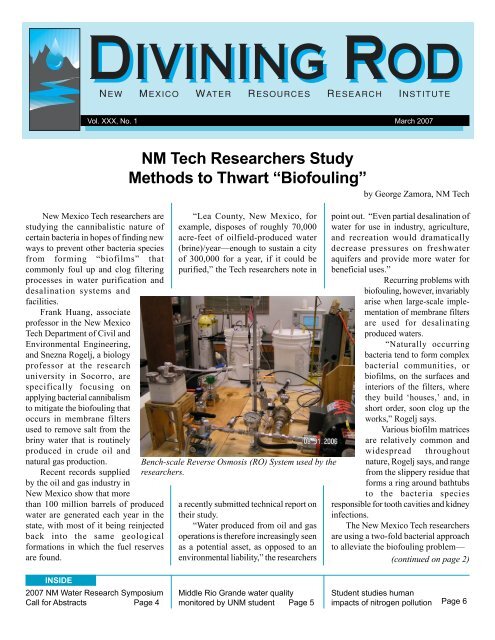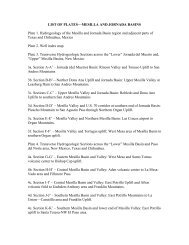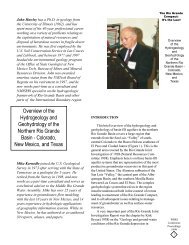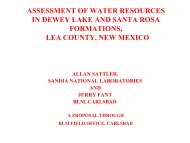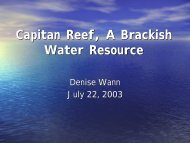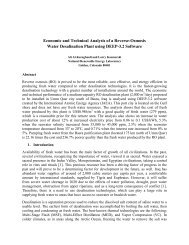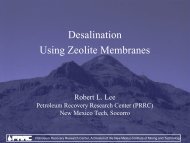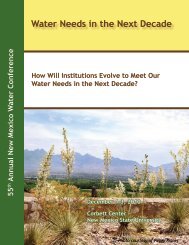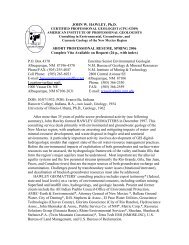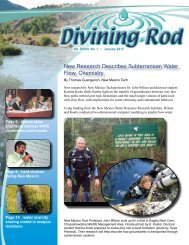Vol. XXX, No. 1 - Water Resources Research Institute - New Mexico ...
Vol. XXX, No. 1 - Water Resources Research Institute - New Mexico ...
Vol. XXX, No. 1 - Water Resources Research Institute - New Mexico ...
You also want an ePaper? Increase the reach of your titles
YUMPU automatically turns print PDFs into web optimized ePapers that Google loves.
<strong>Vol</strong>. <strong>XXX</strong>, <strong>No</strong>. 1 March 2007<br />
<strong>New</strong> <strong>Mexico</strong> Tech researchers are<br />
studying the cannibalistic nature of<br />
certain bacteria in hopes of finding new<br />
ways to prevent other bacteria species<br />
from forming “biofilms” that<br />
commonly foul up and clog filtering<br />
processes in water purification and<br />
desalination systems and<br />
facilities.<br />
Frank Huang, associate<br />
professor in the <strong>New</strong> <strong>Mexico</strong><br />
Tech Department of Civil and<br />
Environmental Engineering,<br />
and Snezna Rogelj, a biology<br />
professor at the research<br />
university in Socorro, are<br />
specifically focusing on<br />
applying bacterial cannibalism<br />
to mitigate the biofouling that<br />
occurs in membrane filters<br />
used to remove salt from the<br />
briny water that is routinely<br />
produced in crude oil and<br />
natural gas production.<br />
Recent records supplied<br />
by the oil and gas industry in<br />
<strong>New</strong> <strong>Mexico</strong> show that more<br />
than 100 million barrels of produced<br />
water are generated each year in the<br />
state, with most of it being reinjected<br />
back into the same geological<br />
formations in which the fuel reserves<br />
are found.<br />
NM Tech <strong>Research</strong>ers Study<br />
Methods to Thwart “Biofouling”<br />
by George Zamora, NM Tech<br />
“Lea County, <strong>New</strong> <strong>Mexico</strong>, for<br />
example, disposes of roughly 70,000<br />
acre-feet of oilfield-produced water<br />
(brine)/year—enough to sustain a city<br />
of 300,000 for a year, if it could be<br />
purified,” the Tech researchers note in<br />
Bench-scale Reverse Osmosis (RO) System used by the<br />
researchers.<br />
a recently submitted technical report on<br />
their study.<br />
“<strong>Water</strong> produced from oil and gas<br />
operations is therefore increasingly seen<br />
as a potential asset, as opposed to an<br />
environmental liability,” the researchers<br />
point out. “Even partial desalination of<br />
water for use in industry, agriculture,<br />
and recreation would dramatically<br />
decrease pressures on freshwater<br />
aquifers and provide more water for<br />
beneficial uses.”<br />
Recurring problems with<br />
biofouling, however, invariably<br />
arise when large-scale implementation<br />
of membrane filters<br />
are used for desalinating<br />
produced waters.<br />
“Naturally occurring<br />
bacteria tend to form complex<br />
bacterial communities, or<br />
biofilms, on the surfaces and<br />
interiors of the filters, where<br />
they build ‘houses,’ and, in<br />
short order, soon clog up the<br />
works,” Rogelj says.<br />
Various biofilm matrices<br />
are relatively common and<br />
widespread throughout<br />
nature, Rogelj says, and range<br />
from the slippery residue that<br />
forms a ring around bathtubs<br />
to the bacteria species<br />
responsible for tooth cavities and kidney<br />
infections.<br />
The <strong>New</strong> <strong>Mexico</strong> Tech researchers<br />
are using a two-fold bacterial approach<br />
to alleviate the biofouling problem—<br />
(continued on page 2)<br />
INSIDE<br />
2007 NM <strong>Water</strong> <strong>Research</strong> Symposium<br />
Call for Abstracts Page 4<br />
Middle Rio Grande water quality<br />
monitored by UNM student Page 5<br />
Student studies human<br />
impacts of nitrogen pollution Page 6
developing ways of breaking down the<br />
biofilms that are already formed and<br />
preventing the bacterial matrix from<br />
forming.<br />
“We looked at injecting these<br />
bacterial cannibals into the<br />
biofilms to burst open the bad<br />
bacteria, but these parasites are<br />
very specific to their hosts, and<br />
you have to match them up<br />
exactly,” Huang says. “This is<br />
difficult to do, so it’s not a<br />
practical solution.”<br />
“<strong>No</strong>w, we’re exploring the<br />
possibilities of using agents to<br />
prevent the bacteria from<br />
sticking to each other before they<br />
form the biofilms on the filters,”<br />
Rogelj adds. “Prevention is a<br />
better approach. . . . You know<br />
what they say, ‘A gram of<br />
prevention is worth a kilogram<br />
of cure.’”<br />
Huang and Rogelj’s research study<br />
has been conducted at the laboratory<br />
scale for the past two years, but the<br />
researchers recently have garnered<br />
A scanning electron micrograph of S. epidermidis<br />
biofilm. The filmy extracellular material, characteristic<br />
for biofilms and secreted by the cells, protects the bacteria<br />
and makes the biofilm tough and difficult to remove.<br />
additional support and funding from<br />
Sandia National Laboratories and the<br />
State of <strong>New</strong> <strong>Mexico</strong> to expand the<br />
research to a “trailer-scale” operation<br />
that can be easily transported and<br />
used for field site testing and<br />
experiments.<br />
“Whatever we come up with,<br />
it has to work all the time to be<br />
entirely reliable,” Rogelj points<br />
out, “not just on some days.”<br />
Huang and Rogelj are joined<br />
in their research study by <strong>New</strong><br />
<strong>Mexico</strong> Tech assistant professor<br />
of biology Scott T. Shors and are<br />
also assisted by several Tech<br />
undergraduate and graduate<br />
students. The research is financed<br />
in large part by funding made<br />
available through the <strong>New</strong><br />
<strong>Mexico</strong> <strong>Water</strong> <strong>Resources</strong><br />
<strong>Research</strong> <strong>Institute</strong>.<br />
(Rogelj continued from page 3)<br />
Current Projects<br />
Co-PI: Mitigation of Membrane<br />
Biofouling by Harnessing Bacterial<br />
Cannibalism, WRRI<br />
PI: Investigation of Degradative<br />
Enzymes Found in Bacitracin, NIH<br />
Co-PI: Mitigation of Biofouling in<br />
Membrane Processes, Sandia Labs<br />
Co-PI: Enzymatic Treatment of<br />
Membrane Biofouling, NMSU<br />
Co-PI: Immuno-PCR Detection of<br />
Biological Food Contamination, WERC<br />
Recent Publications<br />
Shen, H., S. Rogelj, and T.L. Kieft.<br />
2006. Sensitive, Real-time PCR Detects<br />
Low-levels of Contamination by<br />
Legionella pneumophila in Commercial<br />
Reagents. Molecular and Cellular<br />
Probes. 20:147-153.<br />
Allen, R.C., S. Rogelj, S.E.<br />
Cordova, and T.L. Kieft. 2006. An<br />
Immuno-PCR Method for Detecting<br />
Bacillus thuringiensis Cry1Ac Toxin.<br />
Journal of Immunological Methods.<br />
308:109-115.<br />
Zhang, P., S. Rogelj, K. Nguyen,<br />
and D. Wheeler. 2006. Design of a<br />
Highly Sensitive and Specific<br />
Nucleotide Sensor Based on Photon<br />
Upconverting Particles. Journal of the<br />
American Chemical Society.<br />
128:38:12410 -12411.<br />
(Huang continued from page 3)<br />
Co-PI: Mitigation of Biofouling in<br />
Membrane Processes, Sandia Labs<br />
Co-PI: Santa Fe County Lagoon<br />
Wastewater Improvements Project,<br />
Global Filtration, Inc.<br />
Recent Publications<br />
Huang, F.Y.C. and P. Natrajan.<br />
2006. Feasibility of natural zeolites to<br />
remove sodium from CBM produced<br />
water. Journal of Environmental<br />
Engineering. 132:12.<br />
Huang, F.Y.C., R. Gundewar, D.<br />
Steed, and B. Loughridge. 2005.<br />
Feasibility of Using Produced <strong>Water</strong> for<br />
Crosslinked Gel-Based Hydraulic<br />
Fracturing. Society of Petroleum<br />
Engineers. SPE-94320-PP.<br />
Huang, F.Y.C. 2005. Toward Green<br />
Engineering: Multi-Functional Magnetic<br />
Nanoparticles for the Enhancement<br />
of Protein Bioprocessing. Final<br />
report submitted to DOE-WERC.<br />
Huang, F.Y.C. 2004. Waste-to-<br />
Resource Approach for Produced<br />
<strong>Water</strong>. Final report submitted to U.S.<br />
EPA.<br />
Brady, P.V., C.F.J. Colon, G. Carr,<br />
and F.Y.C. Huang. 2002. Soil<br />
Radionuclide Plumes, In Geochemistry<br />
of Soil Radionuclides. Soil<br />
Science Society of America.<br />
Huang, F.Y.C. 2002. The Impact<br />
of Cooling <strong>Water</strong> Pumping at the<br />
Sabinal Site on the Groundwater<br />
Levels in Surrounding Wells. Final<br />
report submitted to Cobisa Corp.,<br />
Houston, TX.<br />
2
Snezna Rogelj<br />
Professor of Biology, NM Tech<br />
E-mail: snezna@nmt.edu<br />
<strong>Research</strong> Focus<br />
Cell-cell adhesive interactions,<br />
particularly as they pertain to immunosuppression<br />
by pesticides, pollutants<br />
and drugs; development of molecular<br />
methods for pathogen detection; nanobio-sensors;<br />
nano-particle toxicity;<br />
biofilm mitigation; anti-bacterial<br />
properties of functionalized<br />
chitosan; and drug discovery.<br />
Education<br />
1985 PhD biochemistry, Boston<br />
University School of Medicine<br />
1982 Summer Physiology<br />
Course at Woods Hole Marine<br />
Biological Laboratory<br />
1976 BS physics with emphasis<br />
on astronomy, Ohio State<br />
University<br />
Meet the <strong>Research</strong>ers<br />
Experience<br />
Snezna Rogelj joined the <strong>New</strong> <strong>Mexico</strong><br />
Tech faculty in 1998. From 1993 to<br />
1998, Dr. Rogelj was a research scientist<br />
at UNM’s Medical School, Department<br />
of Pathology, where she studied the<br />
molecular mechanisms of leukocyte<br />
target recognition in the human immune<br />
and inflammatory responses. From 1989<br />
to 1992 she worked as a scientist for<br />
ASTRA, Biomedical <strong>Research</strong> Center,<br />
Bangalore, India where she carried out<br />
research in parasitology. During her<br />
Lecturer year at Harvard, she studied<br />
tumor angiogenesis. Her postdoctoral<br />
work was at MIT’s Whitehead <strong>Institute</strong><br />
where she participated in molecular<br />
cloning of the first known tumor<br />
suppressor “anti-oncogene.” In<br />
<strong>No</strong>vember 1999, Dr. Rogelj received<br />
the U.S. Department of Energy’s<br />
Defense Program’s Early Career<br />
Scientist and Engineer Award.<br />
Courses Taught<br />
Cell Biology; Advanced Cell<br />
Biology; Molecular Biology<br />
and Molecular Biology<br />
Laboratory; General Biology;<br />
Biology of Cancer; A variety of<br />
seminar courses for seniors and<br />
graduate students (Nanotechnology,<br />
Parasitology, Genetic &<br />
Molecular Basis of Human<br />
Mental Illness, etc.)<br />
(continued on page 2)<br />
Frank Huang, P.E.<br />
Associate Professor<br />
Department of Environmental<br />
Engineering, NM Tech<br />
E-mail: huang@nmt.edu<br />
<strong>Research</strong> Focus<br />
<strong>Water</strong> treatment; wastewater reuse;<br />
soil and groundwater remediation<br />
Education<br />
2001 MS chemical engineering,<br />
Massachusetts <strong>Institute</strong> of Technology<br />
1993 PhD environmental engineering,<br />
Vanderbilt University<br />
1989 MS environmental engineering,<br />
Vanderbilt University<br />
1984 BS civil and environmental<br />
engineering, National Chung-Hsing<br />
University, Taiwan<br />
Experience<br />
Frank Huang joined the faculty at <strong>New</strong><br />
<strong>Mexico</strong> Tech in 1994. While at NM<br />
Tech, he has managed and conducted<br />
research and projects sponsored by the<br />
State of <strong>New</strong> <strong>Mexico</strong>, DOE-WERC,<br />
Sandia National Labs, Los Alamos<br />
National Lab, USEPA, WRRI, Gaz de<br />
France, Bernalillo County, NM,<br />
National Park Service, and other private<br />
companies. Prior to coming to <strong>New</strong><br />
<strong>Mexico</strong>, Dr. Huang worked for one year<br />
at the Gulf Coast Hazardous Substance<br />
<strong>Research</strong> Center. He is a registered<br />
Professional Engineer in <strong>New</strong> <strong>Mexico</strong><br />
and a member of the <strong>New</strong> <strong>Mexico</strong><br />
Wastewater Technical Advisory<br />
Committee appointed by the<br />
NM Secretary of Environment.<br />
Courses Taught<br />
Introduction to Environmental<br />
Science & Engineering; <strong>Water</strong><br />
Treatment Processes Design;<br />
Wastewater Treatment Processes<br />
Design; Unit Operations for<br />
Environmental Engineering; Solid &<br />
Hazardous Waste Engineering;<br />
Physicochemical and Biological<br />
Processes<br />
Current Projects<br />
Co-PI: Mitigation of Membrane<br />
Biofouling by Harnessing Bacterial<br />
Cannibalism, WRRI<br />
Co-PI: Preventive Measures for<br />
Membrane Biofouling, State of <strong>New</strong><br />
<strong>Mexico</strong><br />
(continued on page 2)<br />
3
2007 <strong>New</strong> <strong>Mexico</strong><br />
<strong>Water</strong> <strong>Research</strong> Symposium<br />
Macey Center<br />
<strong>New</strong> <strong>Mexico</strong> Tech<br />
August 14, 2007<br />
Call for Abstracts<br />
Abstracts for consideration for presentations and/or posters at the 2007 <strong>New</strong> <strong>Mexico</strong> <strong>Water</strong> <strong>Research</strong> Symposium will be<br />
accepted through July 6, 2007. Abstracts related to any and all water research and management topics will be considered, but<br />
abstracts that exhibit multidisciplinary work are strongly encouraged. Abstracts must be submitted online via the <strong>New</strong> <strong>Mexico</strong><br />
WRRI homepage: http://wrri.nmsu.edu. Presenters whose papers are accepted for oral presentations will be limited to a 20-<br />
minute talk. The registration fee for everyone, including speakers, poster presenters, and other attendees is $20. The fee will<br />
be waived for students presenting an accepted paper or poster. Final symposium agendas will be emailed to all poster presenters<br />
and speakers in early August and will be posted on the WRRI website.<br />
Technical sessions will be organized around the<br />
following topics:<br />
-<strong>Water</strong> and wastewater treatment and reuse<br />
-Erosion and sediment control<br />
-Reservoir evaporation<br />
-Economics and policy analysis<br />
-<strong>Water</strong>shed assessment, planning, and management<br />
-Wetlands and riparian issues<br />
-Agricultural, industrial, and municipal water use<br />
-Drinking water<br />
-Atmospheric, surface, and groundwater modeling<br />
-Impacts of climate variability on water resources<br />
-Ground and surface water<br />
-Fish and wildlife; endangered species<br />
-<strong>Water</strong> supply<br />
-<strong>Water</strong> management<br />
-Impaired water<br />
-Desalination<br />
-Pollution prevention<br />
-<strong>Water</strong> security<br />
-Ecosystem services<br />
-Public health<br />
-<strong>Water</strong> quality<br />
-Hydrogeoecology<br />
Timetable<br />
Abstract Deadline: July 6, 2007<br />
<strong>No</strong>tification of Acceptance: July 20, 2007<br />
Registration deadline for speakers and poster presenters:<br />
August 3, 2007<br />
Online Registration Deadline: August 12, 2007<br />
Symposium Reception: August 13, 2007; 5:30-6:30 pm<br />
Symposium: August 14, 2007<br />
Sponsored by <strong>New</strong> <strong>Mexico</strong> WRRI in cooperation with<br />
Sandia National Laboratories<br />
Los Alamos National Laboratory<br />
University of <strong>New</strong> <strong>Mexico</strong><br />
<strong>New</strong> <strong>Mexico</strong> Tech<br />
<strong>New</strong> <strong>Mexico</strong> State University<br />
<strong>New</strong> <strong>Mexico</strong> Interstate Stream Commission<br />
<strong>New</strong> <strong>Mexico</strong> Office of the State Engineer<br />
U.S. Geological Survey<br />
American <strong>Water</strong> <strong>Resources</strong> Association -<br />
<strong>New</strong> <strong>Mexico</strong> Section<br />
4
UNM Doctoral Student Monitors Middle Rio Grande <strong>Water</strong> Quality<br />
by Sara Ash, WRRI<br />
With the support of a WRRI student<br />
water research grant, Lydia Zeglin, a<br />
doctoral student in biology at the<br />
University of <strong>New</strong> <strong>Mexico</strong>, and her<br />
advisor, Cliff Dahm, initiated research<br />
along the Middle Rio Grande from the<br />
Otowi gauge above<br />
Cochiti Dam to<br />
Elephant Butte<br />
Reservoir to monitor<br />
water quality and<br />
identify sources of<br />
nutrients in the river.<br />
Along the 300<br />
km study area, Zeglin<br />
collected surface<br />
water samples from<br />
each significant tributary of the Rio<br />
Grande and from the main channel<br />
below each tributary. The samples were<br />
analyzed for temperature, pH, salinity,<br />
dissolved oxygen, cations, anions,<br />
dissolved organic carbon (DOC), the<br />
inorganic nitrogen species ammonium<br />
(NH 4<br />
-N) and nitrate (NO 3<br />
-N), total<br />
“urbanization provides the<br />
most significant inputs of<br />
nutrients that affect Middle<br />
Rio Grande water quality,<br />
specifically in the form of<br />
treated effluent.”<br />
dissolved phosphorous as phosphate<br />
(PO 4<br />
-P), dissolved inorganic carbon,<br />
chlorophyll-a, and carbon quality. Zeglin<br />
focused her research on salinity and the<br />
nutrients DOC, NO 3<br />
-N, and PO 4<br />
-P.<br />
Zeglin observed moderate<br />
variability in the<br />
distribution of<br />
salinity throughout<br />
the study area. The<br />
salinity increases<br />
downstream, especially<br />
during the<br />
summer, and high<br />
salinity inputs<br />
correspond with<br />
wastewater effluent<br />
discharges and certain tributaries. While<br />
evapoconcentration accounts for much<br />
of the surface water salinity variability<br />
in the Middle Rio Grande, tributaries<br />
between Albuquerque and Socorro<br />
where saline, deep groundwater<br />
upwelling occurs may also significantly<br />
affect river salinity.<br />
The distribution of DOC along the<br />
study area did<br />
not vary due to<br />
urbanization or<br />
channel modification,<br />
but the<br />
Confluence of the Albuquerque wastewater treatment plant and<br />
the Rio Grande.<br />
nitrate and<br />
phosphate concentrations<br />
varied greatly.<br />
The maximum<br />
DOC concentrations<br />
were 3<br />
mg/L in the<br />
summer and 4<br />
mg/L in the<br />
winter, which is<br />
relatively low<br />
compared to<br />
modified rivers<br />
Lydia Zeglin presented her research results<br />
at the 2006 <strong>New</strong> <strong>Mexico</strong> <strong>Water</strong> <strong>Research</strong><br />
Symposium at <strong>New</strong> <strong>Mexico</strong> Tech. She received<br />
an award for her presentation.<br />
in other regions, according to Zeglin. The<br />
NO 3<br />
-N and PO 4<br />
-P concentrations<br />
increased below the Bernalillo, Rio<br />
Rancho, and Albuquerque wastewater<br />
treatment outflows. During the summer,<br />
the NO 3<br />
-N and PO 4<br />
-P carried by the river<br />
decrease below the discharges, while<br />
during the winter the nutrients are carried<br />
downstream.<br />
According to Zeglin, the results of<br />
the project suggest that “urbanization<br />
provides the most significant inputs of<br />
nutrients that affect Middle Rio Grande<br />
water quality, specifically in the form of<br />
treated effluent.” The results of this study<br />
reveal the sources and sinks of nutrients<br />
in the Middle Rio Grande and how these<br />
(continued on page 6)<br />
5
(continued from page 5)<br />
change from season to season. “This<br />
information can be used to understand<br />
when and where the greatest threats to<br />
water quality occur in this river and<br />
thereby how to avoid or remediate<br />
related problems,” Zeglin says.<br />
After graduating from UNM, Zeglin<br />
hopes to continue conducting research<br />
focused on the dynamics of bacterial<br />
communities that affect nitrogen<br />
retention and export in desert<br />
freshwaters.<br />
Zeglin sampling in the<br />
Rio Grande, Bosque<br />
del Apache National<br />
Wildlife Refuge.<br />
6<br />
Grant Recipient Studies Human Impacts on Nitrate Dynamics<br />
by Sara Ash, WRRI<br />
Anthropogenic nitrogen has<br />
dramatic and sometimes devastating<br />
effects on many ecosystems. In some<br />
areas of the country, such as the<br />
Mississippi watershed, efforts are being<br />
made to reduce nitrogen pollution, but<br />
to do this effectively nitrogen uptake<br />
must be better understood.<br />
Chelsea Crenshaw, a graduate<br />
biology student at the University of <strong>New</strong><br />
<strong>Mexico</strong>, received one of WRRI’s student<br />
water research grants to study the nitrate<br />
dynamics in hyporheic zones, or the<br />
regions where surface water and<br />
groundwater interact. Hyporheic zones<br />
are an important element in the uptake<br />
and release of nitrogen. “Stream<br />
“The connection between<br />
surface water and groundwater<br />
is very important in<br />
the removal of harmful<br />
nitrogen products in the<br />
desert Southwest,”<br />
hyporheic zones can contribute up to<br />
90% of nitrogen uptake in pristine<br />
streams,” Crenshaw says.<br />
The Rio Salado is an example of a<br />
pristine stream in <strong>New</strong> <strong>Mexico</strong>.<br />
With the help of her advisor Cliff<br />
Dahm, Crenshaw conducted 24-hour<br />
15<br />
NO 3<br />
-<br />
stable isotope tracer releases in<br />
streams to measure nitrate cycling<br />
dynamics. Nine streams with various<br />
intensities and types of human impacts<br />
were selected throughout central <strong>New</strong><br />
<strong>Mexico</strong> and Arizona. Agua Fria River,<br />
Rio Salado, and Sycamore Creek were<br />
used as reference streams, while the Rio<br />
Rancho Drain, Bernalillo Drain, Rio<br />
Puerco, and San Pedro River<br />
represented agriculturally impacted<br />
streams in <strong>New</strong> <strong>Mexico</strong>. Crenshaw<br />
installed a total of nine wells into the<br />
streams at 30 cm deep. The wells had a<br />
high variability in the percentage of<br />
surface water, representing the<br />
connectivity between surface and<br />
groundwater. After the 24-hour 15 NO 3<br />
-<br />
injection, samples were taken and<br />
analyzed for the major cations and<br />
anions.<br />
Crenshaw found that surface water<br />
nitrate and ammonium concentrations<br />
were very low in all of the streams, with<br />
nitrate concentrations ranging from 0.45<br />
to 220 ug/L and ammonium concentrations<br />
below 5 ug/L. The concentrations<br />
of nitrate and ammonium were also low<br />
in the wells. Crenshaw detected 15 NO 3<br />
-<br />
in all of the wells sampled, as well as<br />
15<br />
NH 4<br />
in the agricultural wells.<br />
The results of Crenshaw’s analysis<br />
show that nitrate may be converted to<br />
15<br />
NH 4<br />
and remain in the system instead<br />
of being released into the atmosphere<br />
as a harmless byproduct, such as N 2<br />
. If<br />
15<br />
NH 4<br />
is not released from the system, it<br />
can travel to the ocean, where it is<br />
potentially harmful to aquatic ecosystems.<br />
“The connection between<br />
surface water and groundwater is very<br />
important in the removal of harmful<br />
(continued on page 7)
(continued from page 6)<br />
nitrogen products in the desert<br />
Southwest,” Crenshaw says. “When the<br />
connection is lost there may be storage<br />
of nitrogen, and it may not be released.”<br />
After earning her doctorate from<br />
UNM, Crenshaw will begin postdoctoral<br />
research at Utah State<br />
University in May.<br />
Upcoming Deadlines<br />
May 10-11, 2007 Law of the Colorado<br />
River. CLE International, Las Vegas, NV;<br />
www.cle.com<br />
May 14, 2007 <strong>New</strong> <strong>Mexico</strong> <strong>Water</strong><br />
Markets. H 2<br />
O Economics and John<br />
Shomaker & Associates, Inc., Hotel<br />
Albuquerque at Old Town, Albuquerque,<br />
NM; www.shomaker.com<br />
August 14, 2007 2007 <strong>New</strong> <strong>Mexico</strong><br />
<strong>Water</strong> <strong>Research</strong> Symposium. <strong>New</strong><br />
<strong>Mexico</strong> Tech, Socorro, NM; http://<br />
wrri.nmsu.edu<br />
August 29-Sept. 1, 2007 Sustainable<br />
<strong>Water</strong>, Unlimited Growth, and the Quality<br />
of Life: Can We Have It All Southwest<br />
Hydrology magazine and the Arizona<br />
Hydrological Society, Tucson, AZ;<br />
www.swhydro.arizona.edu/symposium<br />
October 13-18, 2007 <strong>New</strong> <strong>Mexico</strong><br />
Environmental Health Conference, Hotel<br />
Albuquerque at Old Town. Albuquerque,<br />
NM; www.nmehc.net<br />
<strong>No</strong>vember 7-9, 2007 NWRA Annual<br />
Conference. Hyatt Regency, Albuquerque,<br />
NM; www.nwra.org/meetings.cfm<br />
<strong>No</strong>vember 12-15, 2007 43rd AWRA<br />
Annual <strong>Water</strong> <strong>Resources</strong> Conference,<br />
Albuquerque, NM; www.awra.org<br />
(Abstracts deadline: May 14, 2007)<br />
<strong>No</strong>vember 29-30, 2007 52nd Annual<br />
<strong>New</strong> <strong>Mexico</strong> <strong>Water</strong> Conference: Beyond<br />
the Year of <strong>Water</strong>: Living Within Our<br />
<strong>Water</strong> Limitations. La Fonda, Santa Fe,<br />
NM; http://wrri.nmsu.edu<br />
Corrales Drain is an example of an urban system in <strong>New</strong> <strong>Mexico</strong>.<br />
Chelsea Crenshaw (second from left) was presented with an award<br />
for her oral presentation, “Nitrogen Dynamics in Hyporheic<br />
Sediments using 15 NO 3-<br />
N Tracers” at the 2006 <strong>Water</strong> <strong>Research</strong><br />
Symposium at <strong>New</strong> <strong>Mexico</strong> Tech. Sarah Shannon (left) won an award<br />
for her poster presentation, and Lydia Zeglin also received an award<br />
for her oral presentation. All three students are from the University<br />
of <strong>New</strong> <strong>Mexico</strong>. AWRA-<strong>New</strong> <strong>Mexico</strong> Section sponsored the student<br />
presentation and poster competition at the symposium. Peter<br />
Castiglia (right), AWRA-NM representative presented the awards.<br />
Other students receiving awards were Frederick Partey of <strong>New</strong><br />
<strong>Mexico</strong> Tech and Elizabeth Rodriguez of El Paso Community College.<br />
7
WRRI presents the<br />
52nd Annual <strong>New</strong> <strong>Mexico</strong><br />
<strong>Water</strong> Conference<br />
Beyond the Year of <strong>Water</strong>:<br />
Living Within Our <strong>Water</strong> Limitations<br />
The Divining Rod is published by the <strong>New</strong> <strong>Mexico</strong> <strong>Water</strong> <strong>Resources</strong> <strong>Research</strong> <strong>Institute</strong>.<br />
Staff:<br />
M. Karl Wood, Director<br />
Bobby J. Creel, Associate Director<br />
Kristine Kitchens, Coordinator<br />
Catherine T. Ortega Klett, Editor<br />
Peggy S. Risner, Administrative Secretary<br />
Deborah Allen, Records Specialist<br />
<strong>No</strong>vember 29-30, 2007<br />
Santa Fe La Fonda Hotel<br />
photo by Nichole Valdez, 2005 WRRI photo contest honorable mention<br />
<strong>New</strong> <strong>Mexico</strong> WRRI<br />
<strong>New</strong> <strong>Mexico</strong> State University<br />
MSC 3167<br />
P.O. Box 30001<br />
Las Cruces, NM 88003-8001<br />
Phone: 505-646-4337<br />
FAX 505-646-6418<br />
Email: nmwrri@wrri.nmsu.edu<br />
Web page: http://wrri.nmsu.edu<br />
DIVINING ROD<br />
<strong>New</strong> <strong>Mexico</strong> <strong>Water</strong> <strong>Resources</strong> <strong>Research</strong> <strong>Institute</strong><br />
<strong>New</strong> <strong>Mexico</strong> State University, MSC 3167<br />
P.O. Box 30001<br />
Las Cruces NM 88003-8001<br />
<strong>No</strong>nprofit Organization<br />
U.S. Postage PAID<br />
Las Cruces, NM<br />
Permit 162


